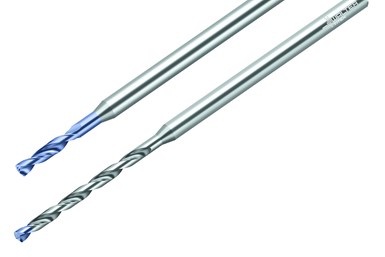Walter Expands Solid-Carbide Micro Drill Product Range
The DB131 and DB133 Supreme micro pilot drill sizes are designed to minimize dimensional variations and extend tool life in steel, cast iron, nonferrous, super alloys, hard materials and other materials.
Share






Hwacheon Machinery America, Inc.
Featured Content
View More

Walter USA has expanded its solid-carbide micro drill line with the addition of the DB131 Supreme micro pilot drill sizes and extended the DB133 Supreme micro drill offering to deep drills up to 30 × DC. According to Walter, these new drills are designed to help achieve maximum process reliability with minimal dimensional variations and extended tool life in steel, cast iron, nonferrous, super alloys, hard materials and other materials (ISO P, K, N, S, H and O). Stainless steel (ISO M) is added to the list with internal coolant capability.
The use of Walter grades WJ30EL and WJ30ER is said to ensure that the drills provide superior wear resistance. In addition, the optimal cutting-edge preparation on the drill provide excellent surface finishes.
A new type of flute design reliably evacuates chips, even with the tinniest drills. This capability ensures that hole depths up to 30 × DC can be easily achieved with the DB133 Supreme micro drill with its 140° point angle. The DB131 Supreme micro pilot drill features a 150° point angle. Emulsion, oil or minimum-quantity lubrication (MQL) can all be used as a coolant with these drills.
The new DB133 drills without internal coolant are available in a diameter range from 0.020-0.116". (0.5-2.95 mm). The diameter range for the micro drills with internal coolant is 0.028-0.116". (0.7-2.95 mm). Length to diameter ratios (L/D) of 5, 8, 12, 16, 20, 25 and 30 × Dc are standard for micro drills with internal coolant and 5 and 8 × DC without internal coolant. This new drill design is effective for applications in the medical, watchmaking, general mechanical engineering, mold and die making, energy and automotive industries.
Related Content
-
Heule Tool Enables Spot Facing of Difficult-to-Reach Areas
The manually actuated bkac spot facing tool is well suited for large boring mills and other open-air machines.
-
Mikron Tool's Drill Provides High Performance in Titanium
The new CrazyDrill Cool Titanium series is designed to provide controlled chip removal, high drilling speeds and long tool life.
-
Ceratizit Product Update Enhances Cutting Tool Solutions
The company has updated its MaxiMill 273-08 face mill, WPC – Change Drill, as well as the HyPower Rough and HyPower Access 4.5-degree hydraulic chucks.



































.png;maxWidth=300;quality=90)

